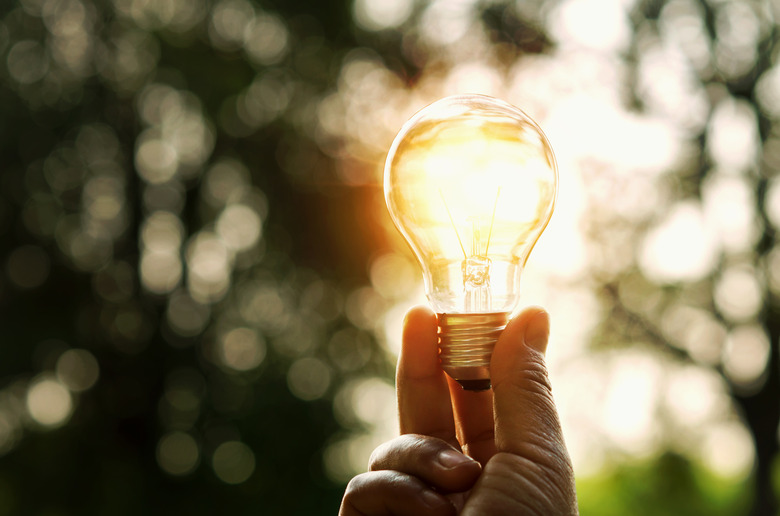What Elements Are In Light Bulbs?
People often credit the invention of the light bulb to famed American inventor Thomas Edison in 1880, but some 40 years before that, British inventors created an arc lamp. Over the years, scientific developments saw new elements replace the carbon rods used in the arc lamp and the carbon filament in Edison's patented bulb. Compared to new types of light bulbs, these early iterations were clunky, inefficient and short-lived. However, the advent and spread of this invention ushered in a new industry, increased the length of workdays, and was an important steppingstone in the spread of electricity across the world.
TL;DR (Too Long; Didn't Read)
Light bulbs started off with elements made of carbon, but over the years inventors added new elements such as tungsten, mercury, chlorine and europium to their toolkits.
Incandescent Light Bulbs, an Early Breakthrough
Incandescent Light Bulbs, an Early Breakthrough
Incandescent bulbs create light by running an electrical current through a fine filament made of metal. This filament heats up until it gives off light. The first light bulbs of this kind had filaments of carbon, although eventually, tungsten replaced it. Tungsten is a more pliable element than carbon and can be heated to 4,500 degrees Fahrenheit. This development came about in 1908 as a product of innovations made by General Electric. Starting in 1913, filaments in bulbs became coiled, and inactive gases such as argon and nitrogen filled the glass bulbs. In 1925, producers began using hydrofluoric acid to add a frostlike effect to the bulbs, which helped spread the light over a wider area. Incandescent light bulbs have improved over the years but are still largely considered to be inefficient, as much of the energy input is lost to heat.
Halogen lamps are variations of incandescents. Their bulbs are made of quartz, and they can contain inert gases such as fluorine, chlorine, bromine and iodine, called halogen elements.
Fluorescent Light Bulbs, Getting Off to a Slow Start
Fluorescent Light Bulbs, Getting Off to a Slow Start
Like incandescent bulbs, the groundwork of what would eventually become fluorescent lighting began in the 19th century. Two Germans – glassblower Heinrich Geissler and physician Julius Plucker – created light by running an electrical current through a glass tube placed between two electrodes that had most of its air removed. Though Edison and peer Nikola Tesla experimented with this technology, it wasn't until the early 1900s that Peter Cooper Hewitt innovated the technology by filling the glass tube with mercury vapor and attaching a device called a ballast to regulate the flow of the current through the tube. Recent developments saw inventors add argon gas to the bulbs and cover their interiors in phosphors. When an electrical current runs through the gas, it releases ultraviolet radiation, which the phosphors absorb and release as visible light. These lights last longer and are more energy efficient than incandescent lights.
Lights of the Present and Future
Lights of the Present and Future
Metal halide lamps are relatively new inventions. They produce a bright light and are fairly energy efficient. They are often used in lighting outdoor sporting matches or construction. Their encompassing bulb holds an arc tube, often made of quartz or ceramic. These tubes contain a starting gas, mercury or iodine, and a metal halide salt. Argon is a common starting gas.
Light-emitting diodes or LEDs, create visible light through a process called electroluminescence. Many gallium-based compounds are used in LEDs, and they also make use of some rare earth metals such as cerium, europium and terbium. LEDs are efficient and cost-effective and have found use in a variety of electronics as humans seek to reduce their impact on Earth's environment.
References
- Encyclopedia Britannica: Arc Lamp
- Department of Energy: The History of the Lightbulb
- The Franklin Institute: Edison's Lightbulb
- Encyclopedia Britannica: Incandescent Lamps
- Encyclopedia Britannica: Tungsten
- Encyclopedia Britannica: Fluorescent Lamp
- Encyclopedia Britannica: Halogen Lamp
- Edison Center: Metal Halide Lamps
- Lighting Research Center: How Do Metal Halide Lamps Work?
- Encyclopedia Britannica: LED
- Encyclopedia Britannica: Halide Mineral
Cite This Article
MLA
Johnson, Doug. "What Elements Are In Light Bulbs?" sciencing.com, https://www.sciencing.com/elements-light-bulbs-7615670/. 25 April 2018.
APA
Johnson, Doug. (2018, April 25). What Elements Are In Light Bulbs?. sciencing.com. Retrieved from https://www.sciencing.com/elements-light-bulbs-7615670/
Chicago
Johnson, Doug. What Elements Are In Light Bulbs? last modified March 24, 2022. https://www.sciencing.com/elements-light-bulbs-7615670/
